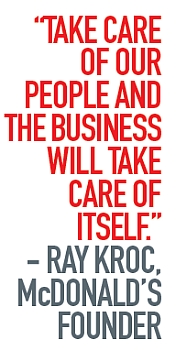Click here to return to Blog Post Intro
Ulrich, Smallwood, and Sweetman started with some key questions for leaders:
- Where are we going?
- How will we make sure we get to where we are going?
- Who goes with us on our business journey?
- Who stays and sustains the organization for the next generation?
They found the answers to those questions had striking similarities and described up to 85% convergence in leadership competencies. This led them to conclude there are five roles & rules that are critical for leaders—as outlined below:
Rule 1: Be a Strategist & Shape the Future
To start, leaders must engage the organization, recognizing that no “one” person knows enough. Invite your savviest outsiders inside, and begin to outline a strategy. A good strategy includes a story that appeals to the heart, mind, and feet. Then, develop a practical mission and reachable vision. Missions and visions not rooted in reality create more cynicism than confidence. Finally, stay curious by continually asking, “What if…?”
Rule 2: Be an Executor & Make Things Happen
As a leader, your ability to execute will enable you to turn strategic aspirations into actions, desires into results, and desired futures into present reality. Leaders executing through high-performing teams succeed at working four issues:
- Setting a purpose backed by a process;
- Managing roles & Making decisions;
- Building relationships; and
- Learning.
To build discipline and manage change in your organization, ask the following questions:
- Leadership Support: To what extent are strong leaders assigned to this project?
- Clear Need: To what extent is there a clear need for the project?
- Clear Outcome: To what extent do we have a clear direction for the change?
- Stakeholder Buy-in: Do we have buy-in and commitment from the people necessary to implement the change?
- Decision Processes: To what extent do we break up the change into decisions that need to be made in the near-term?
- Dedicated Resources: To what extent are we able to institutionalize the change?
- Monitoring & Learning: To what extent do we measure and learn from the change efforts?
Rule 3: Be a Talent Manager & Engage Today’s Talent
To maximize engagement of your team, you need to use strong communication skills. To improve your ability to communicate, remind yourself to be clear about the following:
- What you want to say (the content)
- Why you are saying it (supporting data, or the real nature of the problem, challenge, or opportunity)
- To whom you should say it (recognizing different audiences)
- How you should say it (methods)
- When to share it (timing)
When people know the why, the more readily they accept the what. Leaders should expect to share a message ten times for everyone one time that it will be heard and understood.

Rule 4: Be a Human Capital Developer & Build the Next Generation
As a leader, there are three sets of questions you need to address:
- Which critical jobs will make the largest difference to your results in the next 5-10 years?
- How well positioned are you to staff those critical jobs with the right people?
- What percent of the key positions have qualified talent in place? What is your back-up ratio?
Leaders need to match people to positions to maximize organization productivity. This involves getting to know people and their interests. Unfortunately, that’s more of a rarity than it needs to be. Ulrich and Smallwood point out that at University of Michigan’s Executive Development Programs, they find that fewer than 20% of participants have had a career conversation about how the program fits with their career interests.
Then, cultivate an environment where close working relationships can thrive. Research has established that having a friend at work is one of the main reasons people stay and work hard for a team or organization. As an Out of This World Leader, help foster a supportive community of colleagues.
Rule 5: Be Personally Proficient & Invest in Yourself
Out of This World Leaders demonstrate courage, personal confidence, and security. They make mistakes, but they learn from them. It’s like John Maxwell says, “Sometimes You Win, Sometimes You Learn.”
I’ve noted before that our most powerful leadership tool is a mirror (for more about that, check out this post). Ulrich, Smallwood, and Sweetman agree, recommending that leaders know themselves and understand their predispositions.
They also make the following recommendations to leaders:
- Tolerate stress and maintain your composure even in difficult circumstances.
- Demonstrate learning agility.
- Show exceptional commitment and energy. Others need to see and feel how passionately you enjoy and care about the work you do.
How to Use The Leadership Code:
- Establish a clear theory of leadership.
- Assess leaders.
- Invest in leaders through coaching, job rotations, and action learning.
A 2006 Conference Executive Board Study described different roles of a supervisor, which included: performance advisor; relationship broker; experience broker/optimizer; and career champion. Make sure you’re fulfilling all of those roles well for your team members! A Leadership Brand exists when all levels of leaders know and follow the five rules of the leadership code.
May the Leadership Code serve you well as you shoot for the stars!

